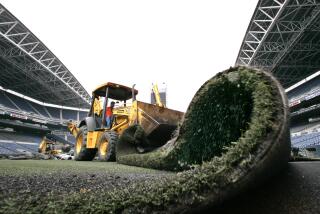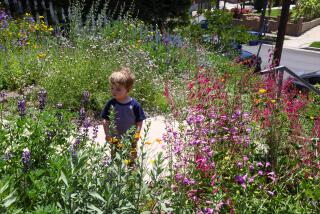Editorial: L.A.’s turf rebates aren’t just a gimmick
- Share via
City Controller Ron Galperin took aim last week at Los Angeles’ popular “Cash in Your Lawn” rebate program, calling the program a “gimmick” that helped get people to pay attention to the drought but didn’t generate much immediate water savings. His audit of Department of Water and Power conservation programs found that Angelenos voluntarily cut their daily water use by 22 gallons per person over the course of the last year, while the turf removal saved only about half a gallon — or, as the controller said, a “drop in the bucket.”
It’s unrealistic to expect dramatic water savings from turf removal in the first year.
Puns aside, Galperin’s comments miss the target. When more than 9,000 households and businesses rip out their thirsty lawns and replace them with drought-tolerant landscaping that requires a fraction of the water over the long run, that’s no gimmick. That’s real, permanent transformation that will help Los Angeles conserve water for years to come.
Besides, it’s unrealistic to expect dramatic water savings from turf removal in the first year. Customers who replace grass with drought-tolerant yards may save little or no water in the beginning, as they have to irrigate to get the new plants established. The savings — typically between 18% and 83% — come in future years when the established landscapes can thrive with minimal water.
It’s also unrealistic to expect that Angelenos will continue taking short showers, letting their lawns die and living with other austerity measures once the drought is declared over. Volunteerism only goes so far. Los Angeles — and California — have steadily reduced water usage over the last two decades through laws and incentives that persuade people to install efficient toilets, shower heads and appliances. It makes sense, then, to focus on landscaping, which soaks up 50% of the state’s urban water use, and to use incentives to spur the cultural and aesthetic shift needed to elevate a water-sipping native garden to the status of a lush green lawn.
Galperin is right that turf rebates are expensive, although less pricey than it would be to import water from Northern California to irrigate those lawns. Going forward, the DWP should tighten the program to make sure that ratepayers get the biggest bang for their rebate buck. The utility could also use “Cash in Your Lawn” to help property owners develop landscapes that are not just drought-tolerant but environmentally sustainable. That should be the ultimate goal: yards that capture rainwater and let it soak into the ground rather than shunting stormwater into the gutters where it carries trash and pollutants to the ocean; plants that provide habitat for bees, birds and other wildlife; and a leafy tree canopy to help counter the climate’s rising temperatures.
Follow the Opinion section on Twitter @latimesopinion and Facebook
More to Read
A cure for the common opinion
Get thought-provoking perspectives with our weekly newsletter.
You may occasionally receive promotional content from the Los Angeles Times.










